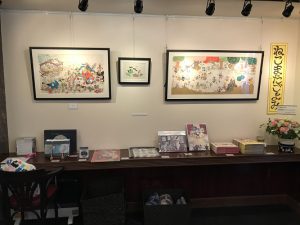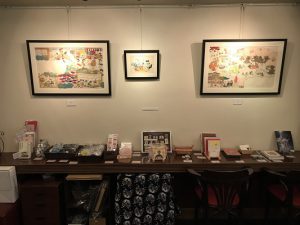石黒亜矢子ねこまたごよみ原画展(愛知県名古屋市千種区姫池通 古美術買取いたします 古美術風光舎名古屋店)
2022.05.21
皆さま、こんにちは。スタッフNでございます。
今日はあいにくの雨ですが、朝から買取が続いておりましてありがたい日でございました。
先日、石黒亜矢子「ねこまたごよみ」原画展に行ってまいりました。

猫好きなら一度は見たことのある絵だと思いますが、一匹一匹に物語があり、笑いもあり、いつ見てもくすっとしてしまいます。
初めて見た時は少しおどろおどろしいと思ってしまったのですが、見れば見るほど愛着がわいてまいります。
春夏秋冬のテーマで書かれた絵本には、猫家族の成長過程もあり、何回読んでも発見があるので楽しいです。
ウォーリーを探せのように、猫家族が絵のどこにいるかを探すのも楽しいですね。
今回は、ねこまたについて調べてみました。
猫又、猫股(ねこまた)は、日本の民間伝承や古典の怪談、随筆などにあるネコの妖怪でございます。大別して山の中にいる獣といわれるものと、人家で飼われているネコが年老いて化けるといわれるものの2種類があるそうです。
中国では日本より古く隋時代には「猫鬼(びょうき)」「金花猫」といった怪猫の話が伝えられていましたが、日本においては鎌倉時代前期の藤原定家による『明月記』の天福元年(1233年)8月2日の記事に、南都(現・奈良県)で「猫胯」が一晩で数人の人間を食い殺した という記述があるそうです。これが、猫又が文献上に登場した初出とされており、猫又は山中の獣として語られていました。ただし『明月記』の猫又は容姿について「目はネコのごとく、体は大きい犬のようだった」と記されていることから、ネコの化け物かどうかを疑問視する声もあり、人間が「猫跨病」という病気に苦しんだという記述があるため、狂犬病にかかった獣がその実体との解釈もございます。また鎌倉時代後期の随筆『徒然草』(1331年頃)に「奥山に、猫またといふものありて、人を食ふなると人の言ひけるに……」と記されております。

江戸時代の怪談集である『宿直草』や『曽呂利物語』でも、猫又は山奥に潜んでいるものとされ、深山で人間に化けて現れた猫又の話があり、民間伝承においても山間部の猫又の話は多くあります。山中の猫又は後世の文献になるほど大型化する傾向にあり、1685年(貞享2年)の『新著聞集』で紀伊国山中で捕えられた猫又はイノシシほどの大きさとあり、1775年(安永4年)の『倭訓栞』では、猫又の鳴き声が山中に響き渡ったと記述されていることから、ライオンやヒョウほどの大きさだったと見られています。1809年(文化6年)の『寓意草』で犬をくわえていたという猫又は全長9尺5寸(約2.8メートル)とありました。
越中国(現・富山県)で猫又が人々を食い殺したといわれる猫又山、会津(現・福島県)で猫又が人間に化けて人をたぶらかしたという猫魔ヶ岳のように、猫又伝説がそのまま山の名となっている場合もあります。猫又山については民間伝承のみならず、実際に山中に大きなネコが住みついていて人間を襲ったものとも見られております。
一方で、同じく鎌倉時代成立の『古今著聞集』(1254年稿)の観教法印の話では、嵯峨の山荘で飼われていた唐猫が秘蔵の守り刀をくわえて逃げ出し、人が追ったがそのまま姿をくらましたと伝え、この飼い猫を魔物が化けていたものと残したが、前述の『徒然草』ではこれもまた猫又とし、山にすむ猫又の他に、飼い猫も年を経ると化けて人を食ったりさらったりするようになると語っております。
江戸時代以降には、人家で飼われているネコが年老いて猫又に化けるという考えが一般化し、前述のように山にいる猫又は、そうした老いたネコが家から山に移り住んだものとも解釈されるようになった。そのために、ネコを長い年月にわたって飼うものではないという俗信も、日本各地に生まれるようになりました。

江戸中期の有職家・伊勢貞丈による『安斎随筆』には「数歳のネコは尾が二股になり、猫またという妖怪となる」という記述が見られます。また江戸中期の学者である新井白石も「老いたネコは『猫股』となって人を惑わす」と述べており、老いたネコが猫又となることは常識的に考えられ、江戸当時の瓦版などでもこうしたネコの怪異が報じられておりました。
一般に、猫又の「又」は尾が二又に分かれていることが語源といわれますが、民俗学的な観点からこれを疑問視し、ネコが年を重ねて化けることから、重複の意味である「また」と見る説や、前述のようにかつて山中の獣と考えられていたことから、サルのように山中の木々の間を自在に行き来するとの意味で、サルを意味する「爰(また)」を語源とする説もございます。老いたネコの背の皮が剥けて後ろに垂れ下がり、尾が増えたり分かれているように見えることが由来との説もあるそうです。
ネコはその眼光や不思議な習性により、古来から魔性のものと考えられ、葬儀の場で死者をよみがえらせたり、ネコを殺すと7代までたたられるなどと恐れられており、そうした俗信が背景となって猫又の伝説が生まれたものと考えられております。また、ネコと死者にまつわる俗信は、肉食性のネコが腐臭を嗅ぎわける能力に長け、死体に近づく習性があったためと考えられており、こうした俗信がもとで、死者の亡骸を奪う妖怪・火車と猫又が同一視されることもあるそうです。
また、日本のネコの妖怪として知られているものに化け猫があるが、猫又もネコが化けた妖怪に違いないため、猫又と化け猫はしばしば混同されることがございます。
なお、カナダで2本の尾を持つネコの写真が撮られているとか。
江戸時代には図鑑様式の妖怪絵巻が多く制作されており、猫又はそれらの絵巻でしばしば妖怪画の題材になっております。1737年(元文2年)刊行の『百怪図巻』などでは、人間女性の身なりをした猫又が三味線を奏でている姿が描かれていますが、江戸時代当時は三味線の素材に雌のネコの皮が多く用いられていたため、猫又は三味線を奏でて同族を哀れむ歌を歌っている、もしくは一種の皮肉などと解釈されております。
このように、日本では昔は猫が恐れられていたわけですね。
昔22歳の猫様で竜のように美しい猫様に出会ったことがありますが、妖怪というか何か超越したような顔立ちにハッとさせられたのを覚えております。
ある一定の年齢を重ねた猫は何か、オーラをまとうのでしょうか。
犬より猫が人気になってしまったこの時代、ねこまた達はどのような気持ちで迎えているのでしょう。
お部屋に物がたくさんあり、掃除が行き届いていないと猫又が来るかもしれませんね。
妖怪が心配な方は是非古美術風光舎まで、買取のご連絡お願い致します。
ではでは

Hello everyone. This is Staff N.
Unfortunately it was raining today, but it was a thankful day for the purchases to continue from the morning.
The other day, I went to Ayako Ishiguro’s “Neko Matagoyomi” original painting exhibition.
If you like cats, you’ll probably have seen this picture once, but each one has a story, laughter, and always makes you feel dull.
When I first saw it, I thought it was a little frightening, but the more I see it, the more I become attached to it.
The picture book written on the theme of spring, summer, autumn and winter is fun because there is a growth process of the cat family and you can discover it no matter how many times you read it.
It’s fun to find out where the cat family is in the picture, like looking for Wally.
This time, I investigated Nekomata.
Nekomata is a cat youkai found in Japanese folklore, classic ghost stories, and writings. There are two types of cats, one is said to be a beast in the mountains and the other is a cat kept in a private house.
In China, the story of monster cats such as “cat demon” and “golden flower cat” was told in the Sui period, which is older than Japan, but in Japan, “Meigetsuki” by Fujiwara no Teika in the early Kamakura period. In the article on August 2, the first year of Tenpuku (1233), there is a description that “Cat” in Nanto (currently Nara Prefecture) ate several people overnight. This is said to be the first appearance of Nekomata in the literature, and was described as a cat or a beast in the mountains. However, since it is stated that the cat or appearance in “Meigetsuki” was “the eyes were like a cat and the body was like a big dog”, some people questioned whether it was a monster of a cat, and humans said ” Since there is a description that it suffered from a disease called “cat straddle disease”, there is also an interpretation that the beast with rabies is the substance. Also, in the essay “Tsurezuregusa” (around 1331) in the latter half of the Kamakura period, it is written that “There is a cat or a cat in Okuyama, and people can say that they eat people …”.
Nekomata, a collection of ghost stories from the Edo period, is said to be lurking in the mountains or in the mountains, and there is a story about Nekomata, who appeared as a human in the deep mountains. There are many stories about Nekomata in the club. It tends to become larger as it becomes a cat in the mountains or later literature, and it is about the size of a cat or a wild boar caught in the mountains of Kii Province in 1685 (Jokyo 2nd year) “New Book Collection”, 1775 (1775) In “Jokyo Shiori” (4th year of Yasunaga), it is described that the bark of Nekomata echoed in the mountains, so it is thought that it was as big as a lion or a leopard. There was a cat that had a dog in it in 1809 (6th year of culture), or a cat with a total length of 9 shaku and 5 inches (about 2.8 meters).
Nekomata is said to have eaten people in Etchu Province (currently Toyama Prefecture), and Nekomata is said to have eaten people in Aizu (currently Fukushima Prefecture). It may be the name of a mountain. It is believed that Nekomatayama is not only folklore, but that large cats actually lived in the mountains and attacked humans.
On the other hand, in the story of the Kokon Chomonju (1254 manuscript), which was also established in the Kamakura period, the Karaneko kept at the Saga Sanso escaped with a treasured guardian sword, and people escaped. He told him that he had disappeared after chasing him, and left this domestic cat as a monster. It is said that after a while, it will become garbled and eat and kidnap people.
After the Edo period, the idea that cats kept in private houses became old and turned into cats became common, and as mentioned above, it is also interpreted as a cat in the mountains or such an old cat moving from the house to the mountain. It became so. As a result, the popular belief that cats are not kept for many years has been born in various parts of Japan.
In “Anzai Essay” by Sadatake Ise, a profession in the middle of the Edo period, there is a description that “a cat of several years old has a bifurcated tail and becomes a youkai called Nekomata.” Arai Hakuseki, a scholar in the middle of the Edo period, also stated that “old cats become’nekomata’and mislead people.” However, the mystery of such a cat was reported.
In general, it is said that the etymology of Nekomata’s “mata” is that the tail is divided into two parts, but this is questioned from a folkloric point of view, and since cats become older and more garbled, in the sense of duplication. There is a theory that it is seen as “again”, and as mentioned above, it was once thought to be a beast in the mountains, so it means that it can freely move between trees in the mountains like a monkey. There is also a theory that the etymology is “)”. There is also a theory that the origin is that the skin on the back of an old cat peels off and hangs down behind, and the tail seems to increase or divide.
Due to its eyesight and mysterious habits, cats have been thought to be magical since ancient times, and it is feared that they will be revived at funerals and that if they are killed, they will be killed by their 7th generation. It is believed that the legend of Nekomata was born. In addition, it is believed that the popular beliefs about cats and the dead are due to the fact that carnivorous cats have a good ability to sniff out rotten odors and have a habit of approaching dead bodies. And Nekomata are sometimes equated.
Also, there is a ghost cat that is known as a Japanese cat youkai, but Nekomata and a ghost cat are often confused because they must be ghosts.
In addition, a picture of a cat with two tails is taken in Canada.
In the Edo period, many picture scrolls of the youkai style were produced, and cats or their picture scrolls are often the subject of youkai paintings. In 1737 (Hyakkai Zukan) published in 1737 (Hyakkai Zukan), Nekomata dressed as a human woman is depicted playing the shamisen, but at the time of the Edo period, the material of the shamisen was female. Since the skin of cats was often used, it is interpreted as playing a cat or shamisen and singing a song that pity the family, or a kind of irony.
As you can see, cats were feared in Japan in the past.
A long time ago, I met a 22-year-old cat who was as beautiful as a dragon, but I remember being surprised by the transcendental features of a youkai.
What is a cat of a certain age wearing an aura?
How do cats and cats feel in this era when cats have become more popular than dogs?
There are a lot of things in the room, and if they aren’t cleaned properly, Nekomata may come.
If you are worried about youkai, please contact the antique art Fukosha to purchase it.
See you soon
*********************
爽やかなお天気が続いておりますね。お片付けなどされてる方もおおいのではないでしょうか。
風光舎では、古美術品や骨董品の他にも絵画や宝石、趣味のお品など様々なジャンルのものを買受しております。
お片付けをされていて、こういうものでもいいのかしらと迷われているものでも、どうぞお気軽にご相談下さいませ。
また風光舎は、出張買取も強化しております。
ご近所はもちろん、愛知県内、岐阜県、三重県その他の県へも出張いたします。
まずは、お電話お待ちしております。
愛知県名古屋市千種区・骨董 買取
『古美術 風光舎 名古屋店』
TEL052(734)8444
10:00-17:00 OPEN

